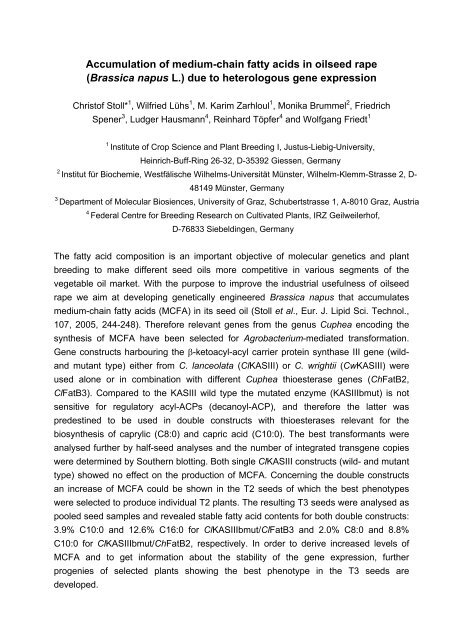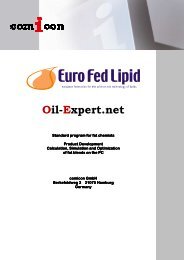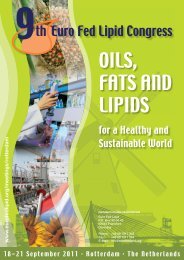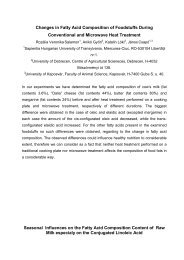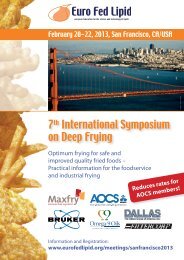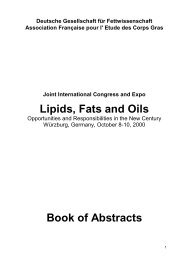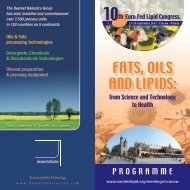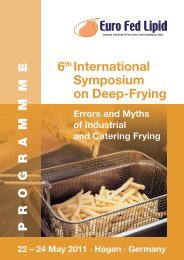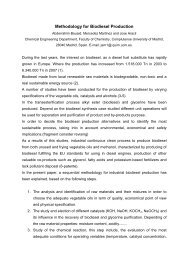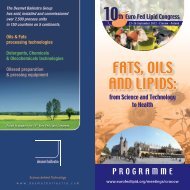Abstracts now available online - Euro Fed Lipid
Abstracts now available online - Euro Fed Lipid
Abstracts now available online - Euro Fed Lipid
You also want an ePaper? Increase the reach of your titles
YUMPU automatically turns print PDFs into web optimized ePapers that Google loves.
Accumulation of medium-chain fatty acids in oilseed rape<br />
(Brassica napus L.) due to heterologous gene expression<br />
Christof Stoll* 1 , Wilfried Lühs 1 , M. Karim Zarhloul 1 , Monika Brummel 2 , Friedrich<br />
Spener 3 , Ludger Hausmann 4 , Reinhard Töpfer 4 and Wolfgang Friedt 1<br />
1<br />
Institute of Crop Science and Plant Breeding I, Justus-Liebig-University,<br />
Heinrich-Buff-Ring 26-32, D-35392 Giessen, Germany<br />
2<br />
Institut für Biochemie, Westfälische Wilhelms-Universität Münster, Wilhelm-Klemm-Strasse 2, D-<br />
48149 Münster, Germany<br />
3<br />
Department of Molecular Biosiences, University of Graz, Schubertstrasse 1, A-8010 Graz, Austria<br />
4 <strong>Fed</strong>eral Centre for Breeding Research on Cultivated Plants, IRZ Geilweilerhof,<br />
D-76833 Siebeldingen, Germany<br />
The fatty acid composition is an important objective of molecular genetics and plant<br />
breeding to make different seed oils more competitive in various segments of the<br />
vegetable oil market. With the purpose to improve the industrial usefulness of oilseed<br />
rape we aim at developing genetically engineered Brassica napus that accumulates<br />
medium-chain fatty acids (MCFA) in its seed oil (Stoll et al., Eur. J. <strong>Lipid</strong> Sci. Technol.,<br />
107, 2005, 244-248). Therefore relevant genes from the genus Cuphea encoding the<br />
synthesis of MCFA have been selected for Agrobacterium-mediated transformation.<br />
Gene constructs harbouring the β-ketoacyl-acyl carrier protein synthase III gene (wildand<br />
mutant type) either from C. lanceolata (ClKASIII) or C. wrightii (CwKASIII) were<br />
used alone or in combination with different Cuphea thioesterase genes (ChFatB2,<br />
ClFatB3). Compared to the KASIII wild type the mutated enzyme (KASIIIbmut) is not<br />
sensitive for regulatory acyl-ACPs (decanoyl-ACP), and therefore the latter was<br />
predestined to be used in double constructs with thioesterases relevant for the<br />
biosynthesis of caprylic (C8:0) and capric acid (C10:0). The best transformants were<br />
analysed further by half-seed analyses and the number of integrated transgene copies<br />
were determined by Southern blotting. Both single ClKASIII constructs (wild- and mutant<br />
type) showed no effect on the production of MCFA. Concerning the double constructs<br />
an increase of MCFA could be shown in the T2 seeds of which the best phenotypes<br />
were selected to produce individual T2 plants. The resulting T3 seeds were analysed as<br />
pooled seed samples and revealed stable fatty acid contents for both double constructs:<br />
3.9% C10:0 and 12.6% C16:0 for ClKASIIIbmut/ClFatB3 and 2.0% C8:0 and 8.8%<br />
C10:0 for ClKASIIIbmut/ChFatB2, respectively. In order to derive increased levels of<br />
MCFA and to get information about the stability of the gene expression, further<br />
progenies of selected plants showing the best phenotype in the T3 seeds are<br />
developed.


